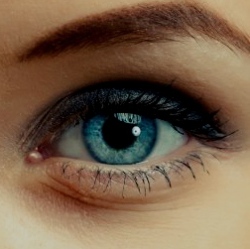
Varjo is a startup based in Finland. The talent comes from the likes of Microsoft and Nokia. This work they have done comes from their original $2M funding, with a second round of funding being pursued. My experience of demos, using what Varjo is calling the “20/20” prototype, shows that they are working in the right direction.
They retrofitted an Oculus Rift with an extra layer of lenses inside the unit. An OLED microdisplay projects an image onto a glass plate over the Oculus lenses. That center piece is said to have 70 times the resolution of the Rift’s image.
“The comparison is apples to apples, taken through the same sense with the same SLR. It’s a world of difference,” said Konttori. “From our point of view, looking at what professionals need from VR, you need human-eye resolution.”
This prototype is a proof-of-concept demo to be sure: the size of the ultra resolution section is on the small side, about a small fraction of the real estate of the entire VR picture (see my approximate illustration of what it felt like below). The edges are a bit jittery in the transition from one image to the other, because the microdisplay has persistence versus the Rift’s low-persistence display.
But, even with that limitation, the demos give you a sense of what VR and AR at such crazy resolutions would be like. A virtual Windows 7 desktop had file explorer open, a 4K trailer to Guardians of the Galaxy Volume 2 and AutoCAD. Whatever was centered in my view was astonishingly detailed.
A video of a prototype back in Finland showed how this tech can work with AR. Using video see-through, a person could have multiple “displays” while they work in the office, at home, or on an airplane. Another example demo from video shows someone manipulating what looks like a model of a home floating in front of them, moving furniture around, for example. Then they click a spot and the virtual home surrounds them at human scale. It looks like you are standing in a VR house that is as detailed as any that could be in a 4K video game.
Varjo wants to address the limitations of current tech.
“The problem with the VR and AR of today is, firstly, that they are all inherently low resolution. We’re talking about one one-hundredth of human-eye resolution. It’s not quite legally blind,” said Konttori. “Optical see-through systems…have narrow fields of view. It’s crippling all the time. And everything you create in AR is very hazy and artificial, ghostly. It’s not life-like. If you’re a professional who wants to showcase a product in mixed reality, it needs to be accurately represented and not as a holographic image.”
The company is aiming for a professional market, aiming to use its tech to create a SteamVR headset that companies will use. They think they could use software and hardware gaze-tracking to move the 70X resolution section around to where you are actually looking, and not just locked in the center of the screen. The microdisplay could physically move or maybe the glass plate that receives the projection could tilt, Urho Konttori is cagey about what the final mechanism will be be like. But he wants to be clear that this isn’t foveated rendering.
“Foveated rendering is used just to decrease the quality and thus decrease the GPU consumption. Where as we are going to enhance the quality. Maybe it’s ‘foveated display’ or something like that,” said Konttori.
He stresses that the total number of pixels being pushed is less than a 4K computer monitor, and so the software can be run today on current desktops and gaming laptops.
There current schedule is to have a prototype of their own headset by the end of this year and giving away hundreds of units to partners. After some feedback and further development, the final headset is supposed to come to market by the end of 2018.
